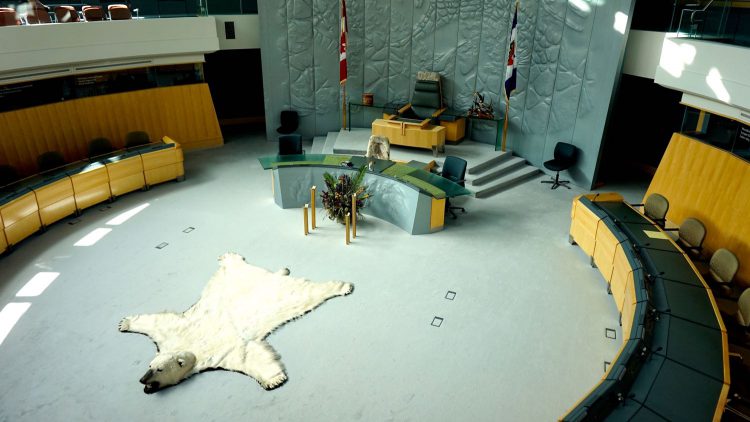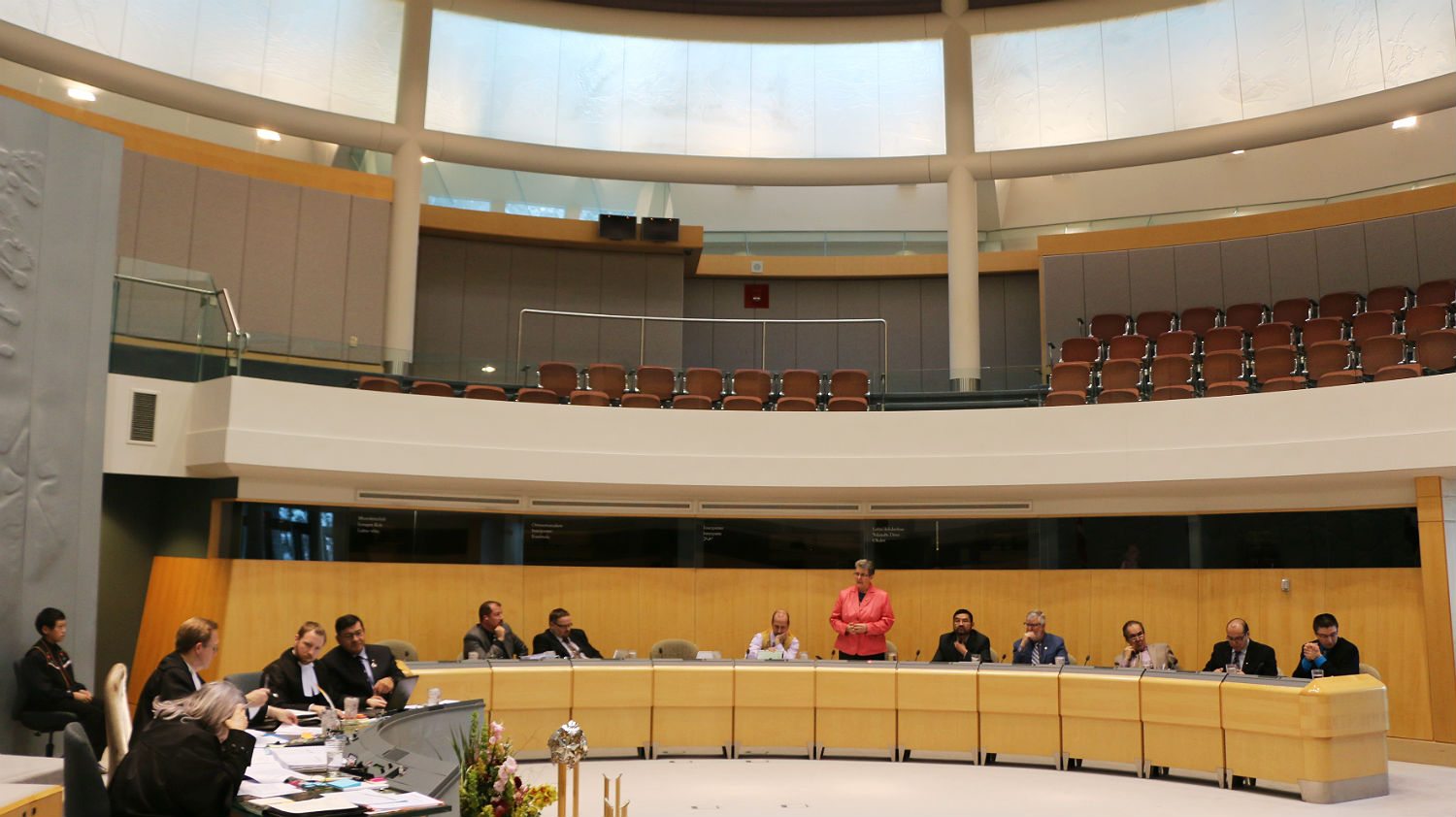You voted for them. So when do they start, who will be the premier, and what will be the priorities?
The territorial government is in transition – MLAs dumped out of their jobs by voters are clearing their desks, while newly elected politicians are working out exactly what it is that they’re supposed to do for the next four years.
On Wednesday, two senior officials laid out what we – and the MLAs – can expect to happen next.
Timeline for the new government
December 1: Day one for new MLAs
“Next Tuesday is when all of the newly elected MLAs will show up for their first day at work,” said Tim Mercer, who has been the clerk of the legislature since 2003.
“New MLAs are usually separated from the remainder to give them some quiet time, learn where the bathrooms are, the names of people, ask questions they may not be comfortable asking.
“In the past, we have planned for and received roughly 33 percent turnover – in terms of budget, space, office allocation, a whole series of things. On Monday night, that assumption went out of the window. We’re facing one of the largest turnovers in the modern history of our assembly. It’s virtually unprecedented. We’ll be sitting with 11 new people now, as opposed to what we’re used to, which is four or five.”
In the week that follows, MLAs will get to grips with payroll details, paperwork and a primer on how consensus government works. In their second week, they’ll take part in a swearing-in ceremony and begin a series of briefings from public servants on outstanding issues.
Government workers are also, for the first time, preparing what they call an “issues wiki” – an internal website offering in-depth briefings on all manner of issues facing the NWT.
“We hope to establish a program of self-study for incoming MLAs,” said Mercer. “We typically bombard them with hours and hours of technical briefings and we know that, after a day or two, we’ve lost most members.
“We’ve established a wiki where members can drill down as far into the issues as they want to. That may become a public document at some point.”
December 12: Leaders’ roundtable
“On this weekend, in previous assemblies, there has been a deliberate effort to consult with Aboriginal leaders prior to the selection of cabinet and any agreement on governing priorities,” said Mercer. Expect those meetings to be scheduled for the weekend of Saturday, December 12.
December 14: MLAs address the public
“This is where MLAs can publicly say what they want to achieve as a legislative assembly for the next four years,” said Mercer, noting that this is a change from previous governments.
“Typically, that discussion takes place in the caucus room and it’s typically in camera. But what’s been recommended is that, this time, the discussion takes place in the assembly – in a public forum – televised and with Hansard proceedings taking place.”
December 16: Choosing a premier
By mid-December, the territorial government needs a little TLC – the territorial leadership committee, which selects the speaker, the premier and the cabinet.
“This is largely the focus of the next 90 days, for better or for worse,” said Mercer. “But nothing about this process is written down anywhere – it’s purely a matter of convention and entirely subject to approval and adoption by the assembly.
“Since the division of the NWT it’s been fairly consistent: the house, when it first sits, selects a speaker by secret ballot. It then selects a premier by way of secret ballot, then a cabinet of six ministers representing three unique geographical areas – north of Great Slave Lake, Yellowknife, and south of Great Slave Lake.”
Background: Night of shocks in NWT election, big-name MLAs ousted
It’s important to emphasize that the premier does not appoint the cabinet. MLAs choose the cabinet. However, the premier does then decide which portfolio each cabinet member will have (health, transportation, education etc).
If there is more than one candidate for a position, the MLAs go through a series of secret ballots, removing the least-favoured candidate each time until one wins a majority of 10 votes or more.
All appointments are then separately ratified by the legislature in a formal session a day later, on December 17.
“The cabinet, unlike in the provincial scene, does not form a monolithic entity. They are each individually appointed by the house and individually enjoy the confidence of the house,” explained Mercer.
“The premier does not get to pick his or her own cabinet – they are presented with one from the legislative branch. The premier cannot dismiss members from cabinet, which is one of the fundamental authorities of the prime minister of Canada or the provincial premiers.
“The premier can appoint ministers to portfolios, remove them and switch them around. That’s largely the extent of their power. The premier is a first among equals, and we don’t see the same concentration of power in the NWT as we do in the south.”
February 18: MLAs in session
The first real session of the 18th Legislative Assembly of the Northwest Territories is, according to a draft schedule, set to begin on Thursday, February 18.
“Typically, at this point, a major disconnect happens,” admitted Mercer. “The members agree upon priorities, select a cabinet and go their separate ways – cabinet goes off to start working on a budget and business plans, and there’s pretty clear line in the sand that’s drawn.
“In January, we’re into cabinet orientation and committee orientation briefings. The first session starts in mid-February, about two weeks later than it normally starts.”
So how do you avoid that disconnect? And what will members actually be talking about when they convene in February?
Setting the NWT’s priorities
You heard a whole bunch of promises, pledges and pie-in-the-sky from candidates during the territorial election campaign. The public servants heard it too – and they kept track.
Once safely installed in their offices, MLAs will be asked to decide – as a group – which of their many election issues are actually the territory’s priorities over the next four years.
David Brock’s job, as the deputy secretary to cabinet, priorities and planning, is to help the new members figure out how to do that.
The NWT’s consensus government system, Brock explains, makes setting priorities a vastly different process to one you’d find in Ottawa or within another provincial government.
“In a party-based system, when individual candidates and a party as a whole run for election, they have a document which says: ‘If you elect me, starting the next day, we will start to implement all these things.’ The party then begins the process of doing that, it’s what they call their governing mandate,” said Brock.
“It’s not that way here. In our system, those decisions are taken after the general election.”
Background: NWT needs ‘extraordinary leadership’ for challenges ahead
However, the system in the NWT is changing. For example, earlier this year, the last government formed a special committee to look specifically at the transition period and set out recommended priorities for the next four years. There’s nothing binding the new government to those priorities, but they are there if wanted.
That committee also made recommendations on ways of changing how the priority-setting process works.
“In the past, generally speaking, caucus gathers and discusses the priorities for the forthcoming term,” said Brock. “Those are then handed over to cabinet, and the public service goes away and figures out how to operationalize that – all the programs, services, policies and amendments to address those priorities.
“But that leaves a gap in terms of timeline – it’s months before the executive branches come back with draft business plans – and a cognitive gap, as it’s difficult for MLAs to draw a clear line between all the priorities set and the specific programs and services laid out in the business plans and the budgets.”
What has been proposed this time around is a new, four-step process:
1. MLAs stand up in public and state their personal priorities on December 14.
2. Caucus (all the MLAs) discusses those priorities and discusses a broad vision for the forthcoming four years.
3. During January and early February, for the first time, cabinet drafts a mandate – helped by public service briefings, conversations with regular MLAs and input from other interested parties. That mandate is then brought to the legislature, where it can be debated, amended and eventually voted upon.
“That allows for an interim step between the caucus priorities and those detailed programs and services. It provides a bit more of a thread between those things,” said Brock.
“One example I like to use is: if caucus says education should be a priority, then a point of strategic direction cabinet might come back with in the mandate is to focus on early childhood education, as opposed to a university or skills training for adults. Cabinet is going to make a choice and put it before the legislative assembly.”
4. “The fourth step is for a mid-assembly review: a period of reflection roughly halfway through the four-year term, for all members to stop and say, ‘Let’s re-examine our priorities and make sure we’ve got this right,'” said Brock.
Regular MLAs: read this part
So you’re a new MLA but you’re not in cabinet. That means you’re a sort-of unofficial opposition, right? Not according to Tim Mercer.
“Consensus government is based on responsible government – an executive branch accountable to a legislative branch. Those members who are not part of an executive branch do not form an official opposition,” Mercer explained.
“An official opposition is a very formal body. It presents itself as a government-in-waiting – an alternative to the existing government, ready to govern if necessary, if the governing party loses the confidence of the house.
“Regular MLAs do not do that. They are not there to embarrass, discredit and defeat and replace the government. What that often means on the floor of the house is that things are not quite as lively or theatrical and, in my view, that is the sign of a strong, well-functioning parliamentary democracy.”
The way Mercer terms it, the cabinet – or executive – ‘proposes’ and the legislature – i.e. the group of regular MLAs – ‘disposes’. In other words, cabinet comes forward with proposals, then the regular MLAs take part in analyzing, critiquing, approving or rejecting those proposals, before monitoring the work that follows.






